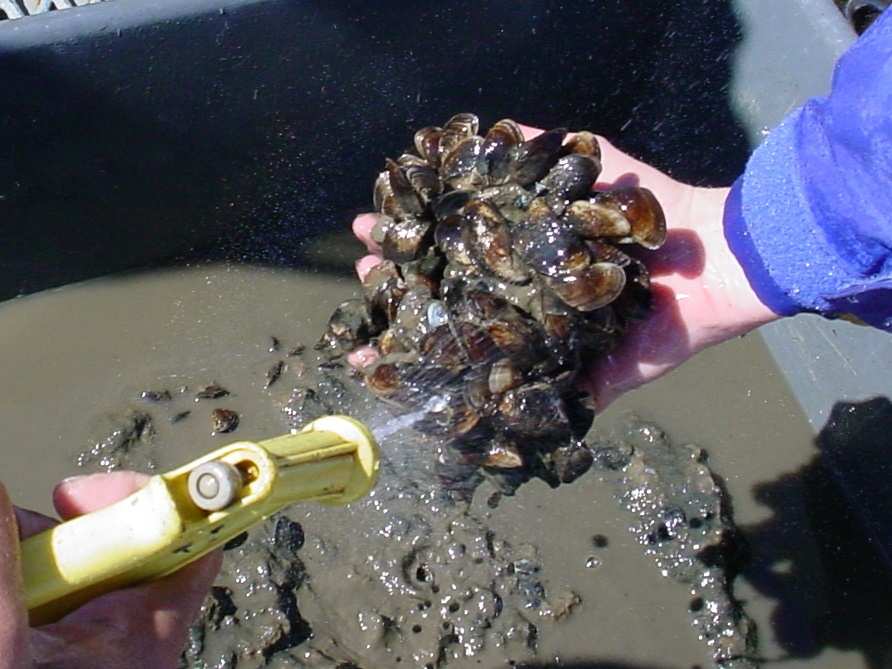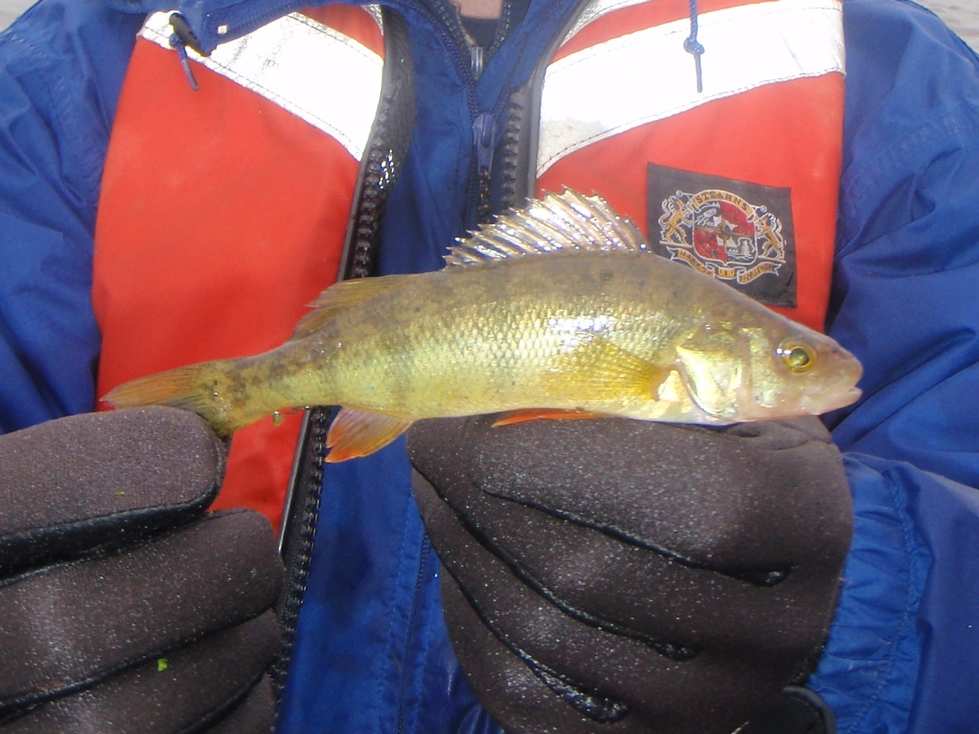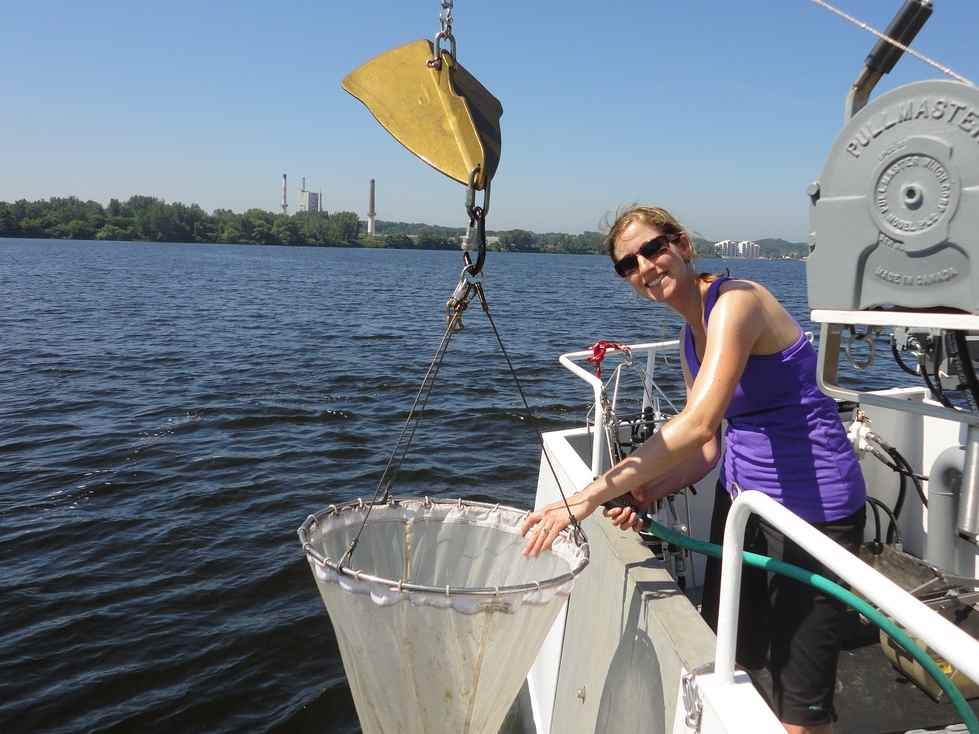Muskegon Lake Long-Term Monitoring Project

Dreissena mussels collected in a Muskegon Lake sediment sample
[1406824896].jpg)
Fyke nets are used to monitor the fish community

Yellow perch captured in Muskegon Lake
Muskegon Lake is a highly disturbed ecosystem listed as an Area of Concern (AOC) in the Great Lakes region. Yet there is a surprising lack of recent information on Muskegon Lake. Detailed and long-term understanding of the lake ecology is essential for wise management of this vital coastal ecosystem that connects the landscape (Muskegon River watershed) to the Lake Michigan.
In 2003, AWRI initiated a long-term monitoring program in Muskegon Lake. An endowment fund at the Community Foundation for Muskegon County, started through the generosity of donors in the greater Muskegon region, helps defray the costs of this project. As residents on the lake, we feel both a responsibility and an obligation to monitor and research the ecological health of this water body. This information is being used to track the restoration and recovery of the lake and, ultimately, demonstrate that it meets the criteria to be removed from the AOC list. Through our monitoring program, we inform the community on the lake's status, provide a foundation for student and faculty research projects, and have leveraged over $10 million in additional funding.
Main Goals
- Observe short-term and long-term changes in the ecological health of Muskegon Lake.
- Understand the mechanisms behind the changes we see in the lake's ecology.
- Integrate Muskegon lake ecology to the watershed level, and to society at large.
- Use the information generated from this study to remove (de-list) Muskegon Lake as one of the Areas of Concern (AOC) in the Great Lakes.

Six sites are being sampled for water quality 3 times per year for a suite of physical, chemical, and biological parameters. Chemical/physical parameters include nutrients (nitrogen and phosphorus), dissolved oxygen, temperature, light transmittance, and Secchi depth. Biological sampling includes measurements of the algal, benthic invertebrate, and fish communities.
As a complement to the long-term monitoring program, the Muskegon Lake Observatory (www.gvsu.edu/wri/buoy) was established in 2011. The observatory consists of a buoy system that collects continuous water quality, hydrology, and meteorological data during the ice-free period.
Each year the monitoring results are communicated to the community in the form of a water quality dashboard based on key water quality indicators.
Monitoring data
- Muskegon Lake Water Quality Dashboard
- Muskegon Lake: 2024 Status and Trends presentation
- Our long-term monitoring data are available upon request and subject to Director approval. Please contact Mike Hassett for further information: [email protected]
- Additional Muskegon Lake data can be downloaded from the Muskegon Lake Observatory website.
Publications
- Dugener, N. M., A. D. Weinke, I. P. Stone, and B. A. Biddanda. 2023. Recurringly hypoxic: Bottom water oxygen depletion is linked to temperature and precipitation in a Great Lakes Estuary. Hydrobiology, 2, 410–430.
- Dugener, N. M., I.P. Stone, A. D. Weinke, and B. A. Biddanda. 2023. Out of oxygen: Temperature and loading drove hypoxia during a warm, wet, and productive year in a Great Lakes Estuary. J. Great Lakes Research 49(5):1015-1028.
- Mader, M.M., C.R. Ruetz, S.A. Woznicki, and A.D. Steinman. 2023. Land cover and water quality of drowned river mouths: Evidence of an environmental gradient along the eastern Lake Michigan shoreline. Journal of Great Lakes Research. In Press.
- Biddanda, B., S. Kendall, A. Weinke, I. Stone, N. Dugener, S. Ruberg, J. Leidig, E. Smith, M. Berg, and G. Wolffe. 2021. Muskegon Lake Observatory buoy data: Muskegon Lake, Michigan: 2011-2019 ver 1. Environmental Data Initiative. 12-21-2021.
- Orzechowski, R.M. and A.D. Steinman. 2022. Assessment of shoreline restoration using macroinvertebrates in a Great Lakes Area of Concern. Environmental Monitoring and Assessment. 194:260.
- Kleindl, P. and A.D. Steinman. 2021. Contrasting trajectories in macrophyte community development after shoreline restoration: Water level obscures trends. Aquatic Botany 169: 103327. doi: 10.1016/j.aquabot.2020.103327
- Mancuso, J.L., A.D. Weinke, I.P. Stone*, S.E. Hamsher, M. Villar-Argaiz, and B.A. Biddanda. 2021. Cold and wet: Diatoms dominate the phytoplankton community during a year of anomalous weather in a Great Lakes estuary. Journal of Great Lakes Research 47(5): 1305- 1315. doi: 10.1016/j.jglr.2021.07.003
- Mancuso, J.L., A.D. Weinke, I.P. Stone, S.E. Hamsher, M.M. Woller-Skar, E.B. Snyder, and B.A. Biddanda. 2021. Bloom and bust: Historical trends of harmful algal blooms in Muskegon Lake, Michigan, a Great Lakes estuary. Freshwater Science 40(3): 463-477. doi: 10.1086/716236
- Scott, J.W., K.G. Gunderson, L.A. Green, R.R. Rediske, and A.D. Steinman. 2021. Perfluoroalkylated substances (PFAS) associated with microplastics in a lake environment. Toxics 9(5): 106. doi: 10.3390/toxics9050106
- Harris, B.S., C.R. Ruetz III, T.J. Ellens, A.D. Weinke, and Biddanda, B.A. 2020. Adult lake sturgeon (Acipenser fulvescens Rafinesque, 1817) occurrence in the Muskegon River system, a Lake Michigan drowned river mouth, USA. Journal of Applied Ichthyology. 36: 547-558. doi: 10.1111/jai.14076
- Senegal, T J., C.R. Ruetz III, G.M. Chorak, D.J. Janetski, D.F. Clapp, G.J. Bowen, and T.O. Höök. 2020. Differential habitat use patterns of yellow perch Perca flavescens in eastern Lake Michigan and connected drowned river mouth lakes. Journal of Great Lakes Research. 46(5): 1412-1422. doi: 10.1016/j.jglr.2020.06.021
- Steinman, A.D., J. Scott, L. Green, C. Partridge, M. Oudsema, M. Hassett, E. Kindervater, and R. Rediske. 2020. Persistent organic pollutants, metals, and the bacterial community composition associated with microplastics in Muskegon Lake (MI). Journal of Great Lakes Research. 46(5): 1444-1458. doi: 10.1016/j.jglr.2020.07.012
- Chorak, G.M., C.R. Ruetz III, R.A. Thum, C.G. Partridge, D.J. Janetski, T.O. Höök, and D.F. Clapp. 2019. Yellow perch genetic structure and habitat use among connected habitats in eastern Lake Michigan. Ecology and Evolution. doi: 10.1002/ece3.5219
- Weinke, A., and B. Biddanda. 2019. Influence of episodic wind events on thermal stratification and bottom water hypoxia in a Great Lakes estuary. Journal of Great Lakes Research. 45(6): 1103-1112. doi: 10.1016/j.jglr.2019.09.025
- Biddanda, B.A., A.D. Weinke, S.T. Kendall, L.C. Gereaux, T.M. Holcomb, M.J. Snider, D.K. Dila, S.A. Long, C. VandenBerg, K. Knapp, D.J. Koopmans, K. Thompson, J.H. Vail, M.E. Ogdahl, Q. Liu, T.H. Johengen, E.J. Anderson, and S.A. Ruberg. 2018. Chronicles of hypoxia: Time-series buoy observations reveal annually recurring seasonal basin-wide hypoxia in Muskegon Lake – a Great Lakes estuary. Journal of Great Lakes Research, 44: 219-229. doi: 10.1016/j.jglr.2017.12.008
- Isely, P., E. Sterrett Isely, C. Hause, and A.D. Steinman. 2018. A socioeconomic analysis of habitat restoration in the Muskegon Lake area of concern. Journal of Great Lakes Research, 44: 330-339. doi: 10.1016/j.jglr.2017.12.002
- Liu, B., C.E. McClean, D.T. Long, A.D. Steinman, and R.J. Stevenson. 2018. Eutrophication and recovery of a lake inferred from sedimentary diatoms originating from different habitats. Science of the Total Environment, 628-629: 1352-1361. doi: 10.1016/j.scitotenv.2018.02.174
- Liu, Q., E.J. Anderson, Y. Zhang, A.D. Weinke, K.L. Knapp and B.A. Biddanda. 2018. Modeling reveals the role of coastal upwelling and hydrologic inputs on biologically distinct water exchanges in a Great Lakes estuary. Estuarine, Coastal and Shelf Science, 209: 41-55. doi:10.1016/j.ecss.2018.05.014
- Salk, K.R., A.D. Steinman, and N.E. Ostrom. 2018. Wetland restoration and hydrological reconnection result in enhanced watershed nitrogen retention and removal. Wetlands, 38: 349- 359. doi: 10.1007/s13157-017-0972-7
- Schmidt, M., B. Biddanda, A. Weinke, E. Chiang, F. Januska, R. Props, and V. Denef. In Press. Microhabitats shape diversity-productivity relationships in freshwater bacterial communities. Ecology.
- Weinke, A.D. and B.A. Biddanda. 2018. From bacteria to fish: Ecological consequences of seasonal hypoxia in a Great Lakes estuary. Ecosystems, 21: 426-442. doi: 10.1007/s10021-017- 0160-x
- Harris, B.S., C.R. Ruetz III, A.C. Wieten, M.E. Altenritter**, and K.M. Smith. 2017. Characteristics of lake sturgeon Acipenser fulvescens Rafinesque, 1817 in a tributary of Lake Michigan, USA: status of the Muskegon River population. Journal of Applied Ichthyology 33: 338-346. https://doi.org/10.1111/jai.13365
- Defore, A.L., A.D. Weinke, M.M. Lindback*, and B.A. Biddanda. 2016. Year-round measures of planktonic metabolism reveal net autotrophy in surface waters of a Great Lakes estuary. Aquatic Microbial Ecology 77(3):139-153.
- Duhamel, S., G. Nogaro, and A.D. Steinman. 2016. Effects of water level fluctuation and sediment– water nutrient exchange on phosphorus biogeochemistry in two Great Lakes coastal wetlands. Aquatic Sciences DOI: 10.1007/s00027-016-0479-y.
- Homola, J.J., C.R. Ruetz III, S.L. Kohler, and R.A. Thum. 2016. Complex postglacial recolonization inferred from population genetic structure of mottled sculpin Cottus bairdii in tributaries of eastern Lake Michigan, U.S.A. Journal of Fish Biology. DOI:10.1111/jfb.13101
- Nogaro, G., A.M. Harris, and A.D. Steinman. 2016. Alum application, invertebrate bioturbation and sediment characteristics interact to affect nutrient exchanges in eutrophic ecosystems. Freshwater Science 35: 597-610.
- Rutherford, E.S., J. Allison, C.R. Ruetz III, J.R. Elliott, J.K. Nohner, M.R. DuFour, R.P. O’Neal, D.J. Jude, and S.R. Hensler. 2016. Density and survival of walleye eggs and larvae in a Great Lakes tributary. Transactions of the American Fisheries Society 145(3):563-577. DOI: 10.1080/00028487.2016.1145135
- Dila, K.D. and B.A. Biddanda. 2015. From land to lake: Contrasting microbial processes across a Great Lakes gradient of organic carbon and inorganic nutrient inventories. J. Great Lakes Research 41: 75-85.
- Weinke, A.D., S.T. Kendall, D.J. Kroll, E.A. Strickler, M.E. Weinert, T.M. Holcomb, A.A. Defore, D.K. Dila, M.J. Snider, L.C. Gereaux, B.A. Biddanda. 2014. Systematically variable planktonic carbon metabolism along a land-to-lake gradient in a Great Lakes coastal zone. Journal of Plankton Research 36: 1528-1542.
- Altenritter, M.E.L., A.C. Wieten, C.R. Ruetz III, and K.M. Smith. 2013. Seasonal spatial distribution of juvenile lake sturgeon in Muskegon Lake, Michigan, USA. Ecology of Freshwater Fish 22:467-478.
- Nelson, W. and A.D. Steinman. 2013. Changing trends in benthic communities in a coastal drowned river mouth lake, a Great Lakes Area of Concern. Journal of Great Lakes Research 39: 7-18.
- Bhagat, Y., and C.R. Ruetz III. 2011. Temporal and fine-scale spatial variation in fish assemblage structure in a drowned river mouth system of Lake Michigan. Transactions of the American Fisheries Society 140:1429-1440.
- Gillett, N. and A.D. Steinman. 2011. An analysis of long-term phytoplankton dynamics in Muskegon Lake, a Great Lakes Area of Concern. Journal of Great Lakes Research 37: 335-342.
- Janetski, D.J., C.R. Ruetz III, Y. Bhagat, and D.F. Clapp. 2013. Recruitment dynamics of age-0 yellow perch in a drowned river mouth lake: assessing synchrony with nearshore Lake Michigan. Transactions of the American Fisheries Society 142:505-514.
- Ruetz, C.R., III, D.L. Strouse, and S.A. Pothoven. 2009. Energy density of introduced round goby compared with four native fishes in a Lake Michigan tributary. Transactions of the American Fisheries Society 138:938-947.
- Biddanda, B.A., A. Steinman, L. Nemeth, Y. Hong and S. Kendall. 2008. Nutrient bioassays of plankton biomass and metabolism in an urbanized drowned river-mouth lake (Mona Lake, Michigan). Journal of Freshwater Ecology 23: 41-53.
- Ruetz, C.R., III, D.G. Uzarski, D.M. Krueger, and E.S. Rutherford. 2007. Sampling a littoral fish assemblage: comparing small-mesh fyke netting and boat electrofishing. North American Journal of Fisheries Management 27:825-831.
- Hong, Y., A. Steinman, B. Biddanda, R. Rediske, and G. Fahnenstiel. 2006. Occurrence of the toxin-producing cyanobacterium Cylindrospermopsis raciborskii in Mona and Muskegon Lakes, Michigan. Journal of Great Lakes Research 32: 645-652.
- Steinman, A.D. and M. Ogdahl. 2004. An innovative funding mechanism for the Muskegon Lake Area of Concern. Journal of Great Lakes Research 30: 341-343.
- Steinman, A.D., M. Ogdahl, R. Rediske, C.R. Ruetz III, B.A. Biddanda, and L. Nemeth. 2008. Current status and trends in Muskegon Lake, Michigan. Journal of Great Lakes Research 34: 169-188.
- Xie, L., J. Hagar, R.R. Rediske, J. O’Keefe, J. Dyble, and A.D. Steinman. 2011. The influence of environmental conditions and hydrologic connectivity on cyanobacteria assemblages, including Cylindrospermopsis raciborskii, in two drowned river mouth lakes. Journal of Great Lakes Research 37: 470-479.
Special thanks to Dr. William Jackson (deceased) and the Muskegon Sportfishing Association for their generous gifts to the endowment.
Contacts
Al Steinman, Project Manager: [email protected]
Ryan Otter, Water Chemistry: [email protected]
Bopi Biddanda, Microbiology: [email protected]
Carl Ruetz, Fish Biology: [email protected]
Mike Hassett, Data Management and Sampling: [email protected]

